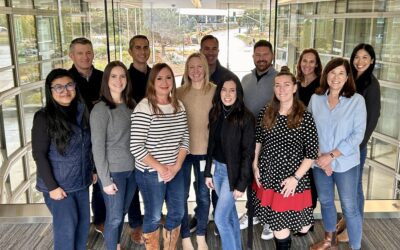“A cloud masses, the sky darkens, leaves twist upward, and we know that it will rain. We also know that after the storm, the runoff will feed into groundwater miles away, and the sky will grow clear by tomorrow. You can only understand the system of a rainstorm by contemplating the whole, not any individual part of the pattern.” Peter Senge, The Fifth Discipline.
As leaders, we are the designers, transformers, and redesigners of systems both within and outside our organizations. Understanding the interdependency of the many connections within the whole is critical to leading with positive impact. When we combine conscious awareness of these connections with intentional integrity and a mindset of abundance, we’re able to lead in a way that supports human flourishing.
Conscious leadership impacts innovation, trust, and belonging. While there are individual practices that leaders can take, we first must understand where we are within the broader system and how our leadership decisions impact a broad range of stakeholders.
Understanding the performance factors at play
By knowing which part of the system you’re focusing on, you can better identify gaps arising from tension or unintended consequence elsewhere. At TiER1, we call these parts of the system performance factors. Conscious leaders take a curious look at where they can maximize value across the system.
Here are interconnected factors and contexts that impact performance:
Individuals
What are the skills, mindsets, knowledge, and well-being factors at play? How might we think of our own individual leadership practice and leading self?
Roles
How does the design of roles, the technology and tools of the role, and the work environment in which the role is performed impact individuals?
Relationships
Across teams, interactions with clients, or shared ways of working for units or departments, how do the dynamics between people impact an individual’s ability to be their best selves? How are we supporting healthy and thriving relationships that demonstrate a concern for our impact on people?
The organization
What are the systems, policies, processes, and practices at play that impact people? How might they support or hinder individuals and teams?
The world
What global factors within your industry, the economy, and the broader world are impacting your organization? Which global factors might your organization positively impact?
With greater clarity of our various leadership contexts, we can better understand who is impacted by our decisions.
Over the years, we’ve seen a positive shift in the role of business at many organizations—from a narrow focus that delivers profit to shareholders, to a holistic focus that’s oriented to serving a broad set of stakeholders. When we can identify changes and systems that positively impact multiple stakeholders while still serving our organizational mission, we significantly amplify our potential for impact.
Identifying and serving broad stakeholders
Sustainability within the workforce and our communities requires a long-term view on leadership as well as clarity on how decisions impact various stakeholders. Conscious leaders embrace a mindset of abundance to find multi-way wins and to unlock opportunities that others might not have seen before—like an employee-owned business model or investing in mental wellness for multiple stakeholders (such as employees, suppliers, and the community at large).
Here are some common stakeholders that many organizations serve. You might have others:
Employees
We believe organizations exist to serve people, not the other way around. When we focus on employee well-being, we free up their energy to better serve clients, customers, and potentially the broader community.
Clients, customers, patients
Without the people we serve, we wouldn’t have a viable organization. Do our decisions make their lives easier or harder?
Local and global community
You may have heard the phrase “triple bottom line” looking at the impact of an organization on people, profit, and planet, which includes both the local and global community.
Suppliers and vendors
How are we supporting and influencing our suppliers and vendors to understand the alignment of their business practices and values with ours as an organization?
Shareholders and investors
How are we providing value to shareholders and investors while also maximizing the organization’s long-term value? For instance, investing in upskilling employees for critical roles to evolve the business might not immediately maximize shareholder value, but it can create positive long-term impacts.
Every business needs a clear strategy to achieve meaningful business goals and performance. Yet leaders can expand the potential for growth and impact by being conscious about how each part of the organization is connected and interacts with the broader world. Think of your next leadership decision as a drop of rain. What are the ripple effects? What growth might you be nourishing for years to come?




